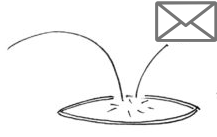how to protect ''NO-MAIL'' domains
Most companies and public bodies register multiple domain names.
Businesses often purchase more than one domain to defend against user error and protect their brands.
Other times to promote events or projects that deserve special visibility.
The numbers can vary from a few dozen domains up to several hundred for a single activity.
They range from about two hundred in a Municipality of a large city, to the thousands of Ferrari and Goldman Sachs.
Up to staggering numbers when you count the total number of registered domains,
which at the end of 2022 reached 350 million domain names, as claimed by Verisign.
Many of these domains are used as a “showcase”. There are no email addresses listed on the website.
Contact requests are generally redirected to forms to be filled in or to social media channels.

The management of email sendings, with the necessary authentications (SPF, DKIM, DMARC, …) is becoming more and more complex.
For this reason, only one domain is usually the one actually used for official external communications via email.
However, the idea of protecting one’s online presence can prove to be a double-edged sword.
Misconfigured “showcase domains” can easily be exploited by malicious actors.
They often abuse the well-known name of the sender, to gain the trust of recipients and demand actions
that expose confidential information or the opening links and attachments.
Recipients are at risk of compromising the security of their systems,
allowing access from the outside to gangs of digital criminals.

The complex authentication systems mentioned above also have their positive sides.
The DMARC protocol was designed to act on fake emails,
to prevent unauthorized individuals or organizations from shipping with our senders.
A quick setup allows you to declare that a given domain is NOT in use,
warning recipients to reject any email from that domain.
It is sufficient to insert a record (single row) in the domain dns with this indication:
_dmarc.yourdomain.com. TXT "v=DMARC1; p=reject"
Whether this rule applies depends on the system receiving the messages.
The good news is that the DMARC protocol has been an approved IETF standard since March 2015.
Most online email services implement it to protect their users.
Messages from “NO-MAIL” domains will be BOUNCED automatically.
In this way, in addition to protecting your company from abuse, you will prevent “old” domains,
that are no longer authorized to send nor authenticated, from being used by mistake.